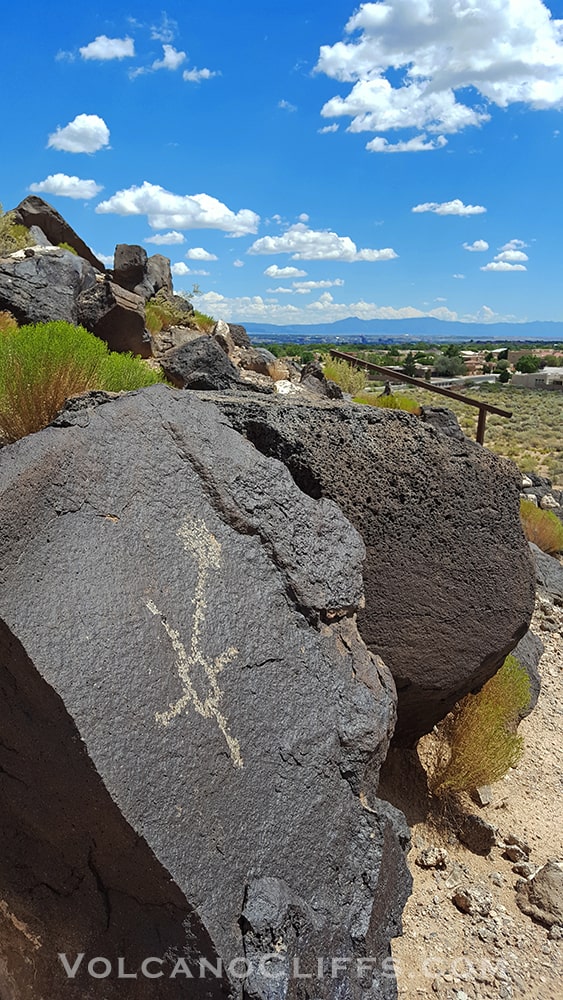The Petroglyph National Monument in Albuquerque, New Mexico, is a powerful record of human history, culture, and expression. Spanning over 17 miles along the West Mesa, this protected area preserves more than 24,000 petroglyphs, symbols and figures etched into volcanic rock by Native peoples and Spanish settlers hundreds of years ago. These images offer insight into cultural traditions, spiritual beliefs, and daily life from as early as 1300 AD. The land itself, formed by ancient lava flows from volcanic eruptions around 200,000 years ago, provides a dramatic backdrop for these enduring carvings.

A petroglyph is an image or symbol that has been carved, pecked, or scratched into the surface of rock. Unlike paintings or drawings, petroglyphs are made by removing part of the rock’s surface through physical force, using tools made of stone or other hard materials. This technique creates a lasting impression that can survive for hundreds or even thousands of years.
Petroglyphs are found all over the world, but in places like the Petroglyph National Monument in Albuquerque, New Mexico, they hold particular significance. Many were created by Native peoples such as the Ancestral Puebloans between 1300 and the late 1600s. These carvings often depict animals, human figures, spirals, hands, and other symbols. While some images may have been used to mark territory or record events, others may have held ceremonial or spiritual meaning.

A petroglyph is an image or symbol that has been carved, pecked, or scratched into the surface of rock. Unlike paintings or drawings, petroglyphs are made by removing part of the rock’s surface through physical force, using tools made of stone or other hard materials. This technique creates a lasting impression that can survive for hundreds or even thousands of years.
Petroglyphs are found all over the world, but in places like the Petroglyph National Monument in Albuquerque, New Mexico, they hold particular significance. Many were created by Native peoples such as the Ancestral Puebloans between 1300 and the late 1600s. These carvings often depict animals, human figures, spirals, hands, and other symbols. While some images may have been used to mark territory or record events, others may have held ceremonial or spiritual meaning.
Several trails wind through the monument, each revealing a different aspect of the area’s cultural and geological significance. Rinconada Canyon Trail is one of the more accessible paths, offering a moderate walk that opens up to hundreds of petroglyphs visible along the canyon walls. Interpretive signs help visitors understand the context of the carvings without disturbing their natural setting. The trail is a meaningful way to experience both the artistry of the people who lived here and the terrain they called home.
The monument is not only a cultural site but a geological one. It includes five volcanic cones, part of the Albuquerque volcanic field. These formations played a key role in shaping the land and creating the dark basalt canvas that made petroglyph creation possible. One of the most recognized volcanic remnants in the area is the formation often referred to as the Three Sisters, which stands just west of Albuquerque. These three cones serve as both geological landmarks and a symbol of the land’s powerful natural forces.

Search all available homes for sale. View property photos, listing details, and schedule showings.
The Petroglyph National Monument lies on the western edge of Albuquerque, yet it remains accessible to residents and visitors alike. The Anzures Trailhead, located west of Unser Blvd, offers a starting point for those who enjoy linking up with paths that stretch toward the monument’s outskirts. It’s an example of how the city’s outdoor spaces are interconnected, inviting exploration and physical activity while maintaining ties to deeper cultural narratives.
Visitors are encouraged to approach the petroglyphs with thoughtfulness. These images are more than historical remnants, they are part of an ongoing story. For many Puebloan and tribal communities, the monument remains a sacred site. Interpretive programs and educational materials provided by the National Park Service help promote awareness of the petroglyphs’ cultural significance, not just their visual appeal.
The Petroglyph National Monument is more than a destination; it is a space for learning, contemplation, and connection. It encourages each visitor to slow down and consider what these markings meant to those who created them, and what they continue to mean today.

Whether you’re looking to buy vacant land, a home or simply curious what your property is worth in today’s market, we can help. You can call, text or e-mail us any time.
Call, text or e-mail us today: